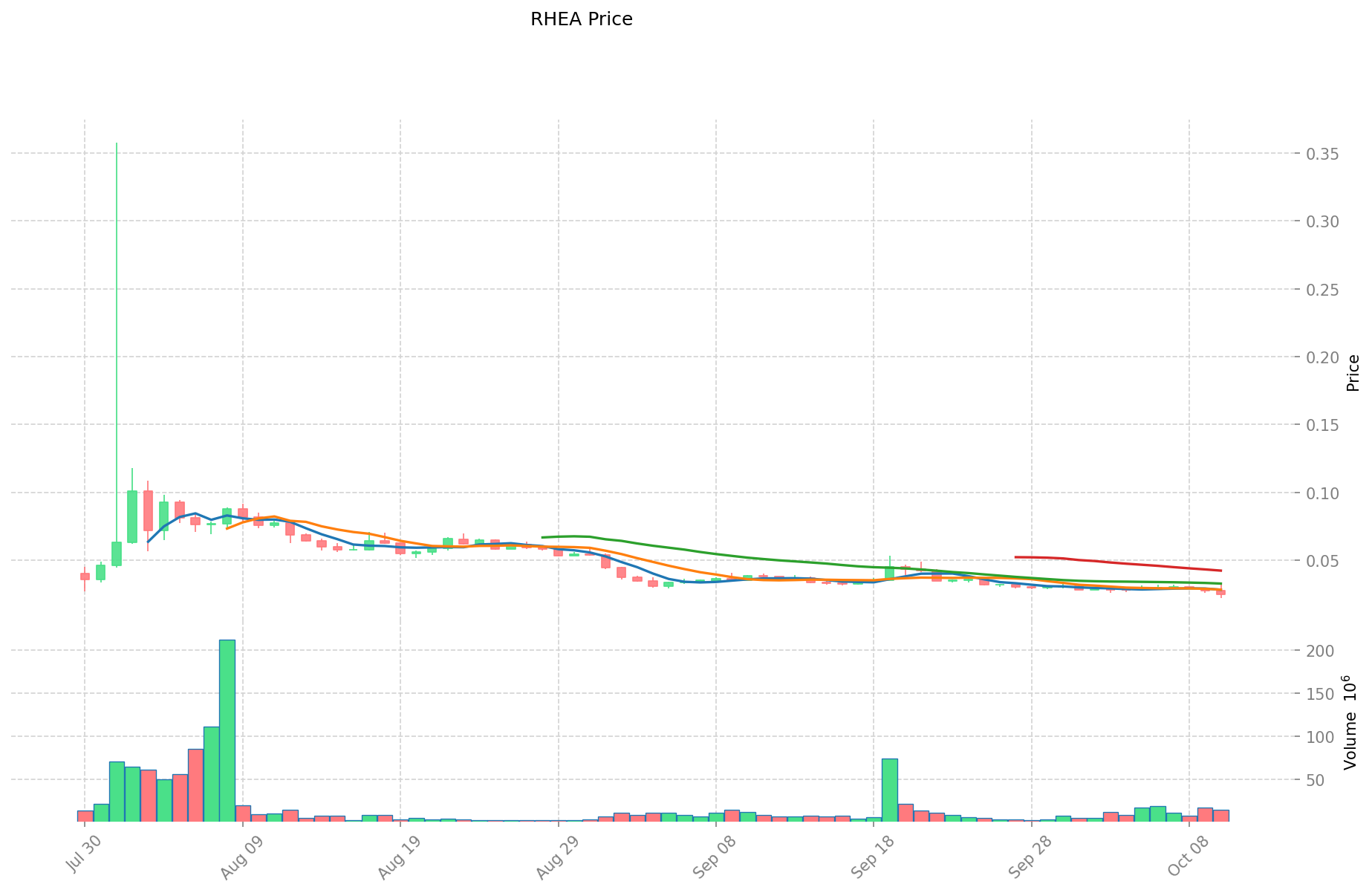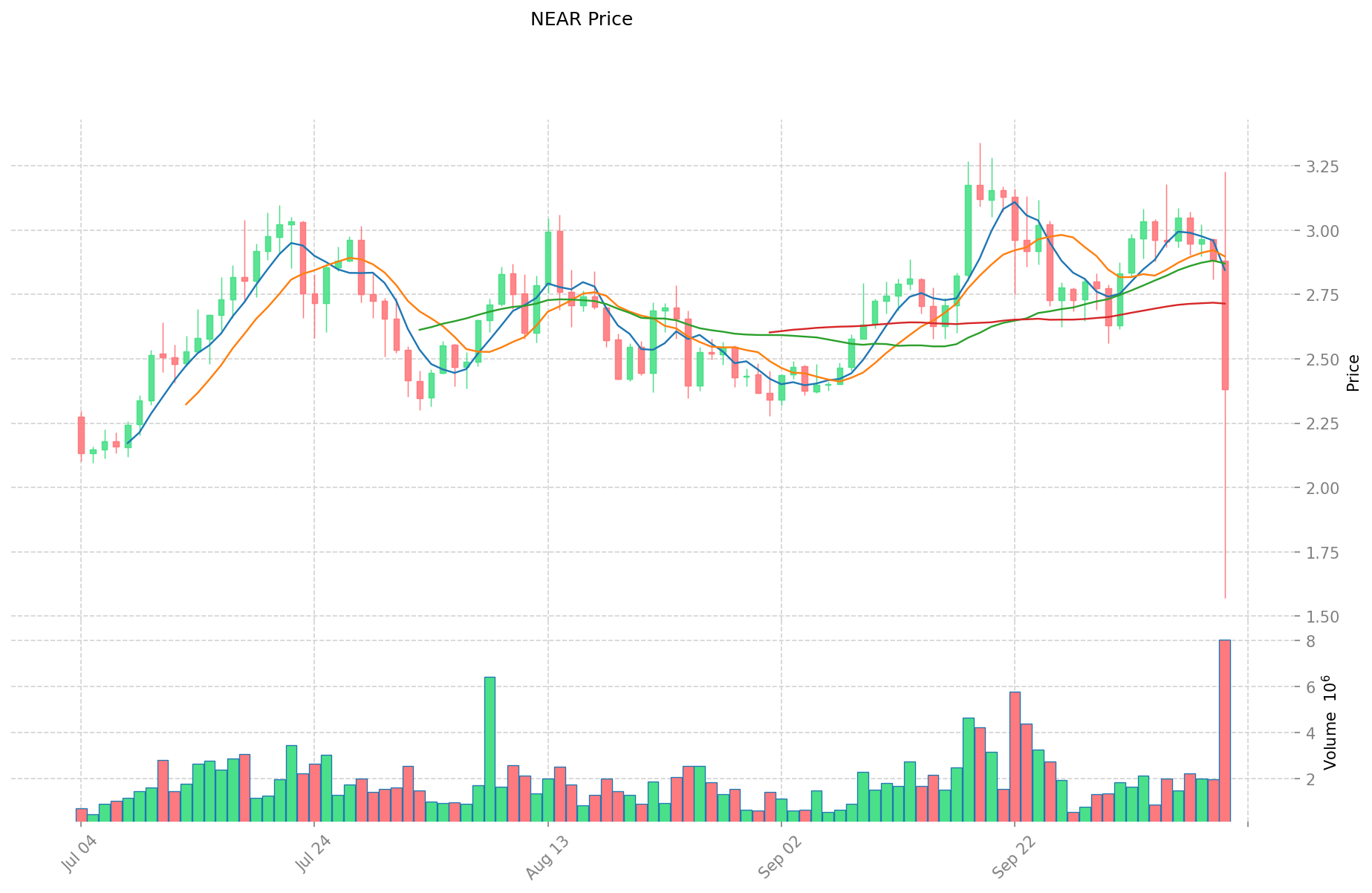RHEA vs NEAR: Comparação entre duas plataformas blockchain para aplicações descentralizadas
Introdução: Comparação de Investimento RHEA vs NEAR
No universo das criptomoedas, comparar RHEA e NEAR tornou-se pauta constante entre investidores. Os dois ativos apresentam diferenças marcantes em capitalização de mercado, cenários de uso e desempenho de preços, além de ocuparem posições distintas no ecossistema cripto.
RHEA (RHEA): Surgiu como evolução inovadora das soluções DeFi originais do NEAR, com o objetivo de criar uma base sólida para a próxima geração de projetos DeFi na rede NEAR.
NEAR (NEAR): Desde 2020, destaca-se como protocolo básico altamente escalável, reconhecido por acelerar o suporte a DApps em dispositivos móveis.
Este conteúdo traz uma análise completa da comparação de valor de investimento entre RHEA e NEAR, abordando históricos de preço, mecanismos de oferta, adesão institucional, ecossistema tecnológico e projeções futuras, buscando resolver a dúvida central do investidor:
"Qual é a melhor compra no momento?"
I. Histórico de Preço e Status Atual de Mercado
Tendências de Preços de RHEA (Moeda A) e NEAR (Moeda B)
- 2025: RHEA alcançou o topo histórico de US$ 0,35778 em 1 de agosto de 2025, reflexo de sua fusão estratégica e rebranding.
- 2025: NEAR avançou para US$ 3,23 em setembro, impulsionado pela maior procura pela sua plataforma blockchain com foco em IA.
- Análise comparativa: No ciclo recente, RHEA caiu do pico de US$ 0,35778 para o mínimo de US$ 0,022, enquanto NEAR manteve-se mais estável, acima de US$ 2.
Situação Atual de Mercado (2025-10-11)
- Preço atual RHEA: US$ 0,02419
- Preço atual NEAR: US$ 2,393
- Volume negociado em 24h: RHEA US$ 382 790,92 vs NEAR US$ 23 509 611,34
- Índice de Sentimento de Mercado (Fear & Greed Index): 27 (Medo)
Clique para consultar preços em tempo real:
- Veja o preço atual de RHEA Preço de Mercado
- Veja o preço atual de NEAR Preço de Mercado


II. Principais Fatores que Influenciam o Valor de Investimento em RHEA vs NEAR
Comparação dos Mecanismos de Oferta (Tokenomics)
- RHEA: Camada unificada de liquidez e empréstimos para o ecossistema NEAR
- NEAR: Token nativo da rede blockchain NEAR
- 📌 Padrão histórico: Conforme a adoção avança, os principais protocolos DeFi do ecossistema tendem a capturar valor relevante.
Adoção Institucional e Aplicações de Mercado
- Posição institucional: RHEA se consolida como principal projeto DeFi do NEAR
- Adoção corporativa: RHEA atua como DEX e plataforma de empréstimos de referência no DeFi de NEAR
- Perspectiva regulatória: A integração da RHEA com OmniBridge sinaliza expansão para ambientes EVM além do NEAR
Desenvolvimento Técnico e Fortalecimento do Ecossistema
- Atualizações técnicas da RHEA: Integração do OmniBridge para conectividade com EVM e outras redes
- Desenvolvimento técnico NEAR: Infraestrutura base para RHEA e outras aplicações DeFi
- Comparativo de ecossistemas: RHEA representa a união do maior DEX e plataforma de empréstimos do NEAR, tornando-se o centro do DeFi no ecossistema NEAR
Fatores Macroeconômicos e Ciclos de Mercado
- Performance em ambientes inflacionários: O valor da RHEA, como protocolo DeFi, depende da adoção e uso do ecossistema NEAR
- Política monetária global: O crescimento está ligado às condições do mercado cripto e ao desempenho do setor DeFi
- Fatores geopolíticos: A expansão da RHEA para além do NEAR visa captar valor e liquidez cross-chain
III. Projeção de Preços 2025-2030: RHEA vs NEAR
Projeção de Curto Prazo (2025)
- RHEA: Conservador US$ 0,0181-0,0245 | Otimista US$ 0,0245-0,0314
- NEAR: Conservador US$ 1,68-2,43 | Otimista US$ 2,43-3,08
Projeção de Médio Prazo (2027)
- RHEA pode entrar em fase de valorização, com preços estimados entre US$ 0,0201-0,0383
- NEAR pode estabilizar, com preços estimados entre US$ 2,30-3,98
- Principais vetores: influxo institucional, ETFs, expansão do ecossistema
Projeção de Longo Prazo (2030)
- RHEA: Base US$ 0,0415-0,0445 | Otimista US$ 0,0445-0,0552
- NEAR: Base US$ 4,34-4,61 | Otimista US$ 4,61-6,23
Aviso: Esta análise tem fins informativos e não constitui orientação financeira. O mercado de criptomoedas é altamente volátil e imprevisível. Realize sempre sua própria análise antes de investir.
RHEA:
| Ano | Máximo Previsto | Média Prevista | Mínimo Previsto | Variação (%) |
|---|---|---|---|---|
| 2025 | 0,0313984 | 0,02453 | 0,0181522 | 1 |
| 2026 | 0,036912744 | 0,0279642 | 0,026286348 | 15 |
| 2027 | 0,03827739696 | 0,032438472 | 0,02011185264 | 34 |
| 2028 | 0,0427831007208 | 0,03535793448 | 0,028286347584 | 46 |
| 2029 | 0,050010262528512 | 0,0390705176004 | 0,028912183024296 | 61 |
| 2030 | 0,055230083679925 | 0,044540390064456 | 0,041422562759944 | 84 |
NEAR:
| Ano | Máximo Previsto | Média Prevista | Mínimo Previsto | Variação (%) |
|---|---|---|---|---|
| 2025 | 3,08356 | 2,428 | 1,67532 | 1 |
| 2026 | 3,995881 | 2,75578 | 1,515679 | 14 |
| 2027 | 3,98347999 | 3,3758305 | 2,29556474 | 40 |
| 2028 | 4,3419931891 | 3,679655245 | 2,53896211905 | 53 |
| 2029 | 5,214071482165 | 4,01082421705 | 3,8102830061975 | 67 |
| 2030 | 6,226804596970125 | 4,6124478496075 | 4,33570097863105 | 92 |
IV. Comparação de Estratégias de Investimento: RHEA vs NEAR
Estratégias de Longo Prazo vs Curto Prazo
- RHEA: Indicado para investidores focados no potencial DeFi e na evolução do ecossistema
- NEAR: Apropriado para quem busca infraestrutura blockchain e estabilidade de plataforma
Gestão de Risco e Alocação de Ativos
- Perfil conservador: RHEA: 20% | NEAR: 80%
- Perfil agressivo: RHEA: 60% | NEAR: 40%
- Ferramentas de hedge: alocação em stablecoins, opções, portfólios multicurrency
V. Comparativo de Riscos Potenciais
Risco de Mercado
- RHEA: Volatilidade superior devido à menor capitalização e à dinâmica do setor DeFi
- NEAR: Exposição às tendências gerais do mercado de blockchain e cripto
Risco Técnico
- RHEA: Escalabilidade, estabilidade de rede e vulnerabilidades em contratos inteligentes
- NEAR: Congestionamentos em períodos de alta demanda e possíveis falhas de segurança
Risco Regulatório
- Políticas regulatórias globais podem impactar ambos, com protocolos DeFi como RHEA sob maior observação
VI. Conclusão: Qual é a Melhor Compra?
📌 Resumo do Valor de Investimento:
- Diferenciais RHEA: Hub central DeFi no NEAR, potencial elevado de valorização
- Diferenciais NEAR: Plataforma blockchain consolidada, ampla adoção e estabilidade
✅ Recomendações de Investimento:
- Novos investidores: Priorize NEAR para maior estabilidade
- Investidores experientes: Equilíbrio entre RHEA e NEAR
- Institucionais: Posição estratégica em ambos, com NEAR como ativo principal e RHEA para exposição ao DeFi
⚠️ Aviso de Risco: O mercado cripto é altamente volátil. Este artigo não representa aconselhamento de investimento. None
VII. FAQ
P1: Quais as principais diferenças entre RHEA e NEAR? R: RHEA é protocolo DeFi desenvolvido sobre o NEAR, focado em liquidez integrada e empréstimos. NEAR é o token nativo da rede blockchain NEAR e serve de base para aplicações, incluindo a própria RHEA.
P2: Qual moeda apresentou mais estabilidade de preço recentemente? R: NEAR demonstrou estabilidade superior nos ciclos recentes. Enquanto RHEA recuou do topo de US$ 0,35778 ao mínimo de US$ 0,022, NEAR permaneceu acima de US$ 2, evidenciando maior resiliência.
P3: Como comparam as projeções de preço futuro para RHEA e NEAR? R: Até 2030, a estimativa otimista para RHEA é US$ 0,0415-0,0552, enquanto para NEAR é US$ 4,34-6,23. NEAR apresenta metas mais altas em valor absoluto, mas RHEA pode ter maior potencial percentual de valorização, dado seu preço atual.
P4: Quais os principais riscos ao investir em RHEA e NEAR? R: RHEA sofre volatilidade extra pela menor capitalização e exposição ao DeFi. NEAR depende das tendências gerais do mercado blockchain. Ambas enfrentam riscos técnicos (escalabilidade, segurança) e desafios regulatórios.
P5: Como investidores institucionais devem abordar RHEA e NEAR? R: Institucionais podem optar por posicionamento estratégico nos dois: NEAR como ativo principal de infraestrutura blockchain e RHEA para participação direcionada no DeFi do NEAR.
P6: Quais fatores podem impulsionar o crescimento da RHEA nos próximos anos? R: O avanço da RHEA depende da adoção do NEAR, expansão dos serviços DeFi, integração com OmniBridge para acessar ecossistemas EVM, e do fortalecimento geral do setor DeFi.
P7: Como o sentimento atual do mercado afeta decisões de investimento em RHEA e NEAR? R: O Fear & Greed Index em 27 indica cenário de medo, podendo abrir oportunidades de compra em ambos, desde que o investidor adote cautela e estratégias de preço médio frente à incerteza.
Compartilhar
Conteúdo